Translate this page into:
An Interventional Study to observe the Impact of Back and Core Body Strengthening Program among Helicopter Pilots
Abstract
Introduction:
Flight related low back pain (LBP) among helicopter pilots is frequent and may influence flight performance. In addition, this leads to loss of pilot hours available for flying duties. Prolonged confined sitting posture with poor ergonomics of seat during flights seems to weaken lumbar trunk (LT) muscles with associated secondary transient pain. Aim of the study was to investigate if structured training could improve muscular function of lower back and improve LBP among helicopter pilots.
Method:
An interventional study was conducted on 25 male helicopter (Chetak) pilots wherein the subjects were administereda back and core strengthening training program over a period of 12 weeks. Exercises recommended were designed specifically to improve lumbar trunk muscular endurance and core body stength. The pilots were examined before and after the training program by appropriote lumbar trunk muscular endurance tests. Their perception towards pain, function and quality of health were surveyed by employing a questionnaire called ‘SF 36’. The control group consisted of 25 pilots matched in age and gender who did not undergo the training program was also tested in a similar manner.
Results:
After completion of interventional study pre and post analysis was carried out. Paired t-test was applied for pre and post exercise analysis of data in each group. Independent sample t-test was used to compare the data between the test and the control group. The results showed significant differences amongst the test and the control group post exercise (p<0.05). There was a significant improvement in endurance of the lumbar musculature function and quality of health in the test group post administration of training program.
Conclusion:
This study indicates that participants who performed a 12 week structured exercise program had improved muscle endurance at the end of the program. The helicopter pilots also experienced improved function and quality of health.
Keywords
Backache
Helicopter pilots
Core strengthening
Exercise program
INTRODUCTION
Flight related lower back pain is frequent among military helicopter pilots [1 - 5]. The prevalence rate amongst Indian military helicopter pilots has been reported to be as high as 48.5 to 100% in various studies [6 - 9]. This leads to crucial loss of pilot hours available for flying duties and has a significant impact on flying missions. Prolonged confined sitting posture with poor ergonomics of seat during flights seems to weaken the lumbar trunk (LT) muscles and thereby induces pain in the lower back which typically occurs post-flight and of variable duration. The Army helicopter pilots in India fly various helicopters varying from vintage ones like Chetak and Cheetah to the modern and technologically superior helicopters like the Advanced Light Helicopter (ALH). The malady of low back ache in Chetak pilots is specifically attributed to the malposture of back due to poor seat ergonomics and placement of controls as reported in various studies [6,7]. The malposture which was brought out by these studies is due to a generalised flexion at cervical and thoracic region with neutralised lumbar lordosis and slight left lateral rotation of the spine due to the position of controls.
Based on the results of various studies and review of literatures it can be inferred that low back ache in helicopter pilots is attributable to asymmetrical posture, static posture and prolonged seating. In a typical helicopter flying, the pilot sits in an unnatural, asymmetric posture by bending forward and lateral (left) along with twisting of spine. On prolong duration, such posture leads to muscle fatigue and variable degree of pain. Whereas the static posture causes local tissue ischemia thereby increasing the muscle fatigue and fatigue related pain. Prolonged seating position which causes flattening of the lumbar lordosis and thereby increases the intervertebral disc pressure, also contributes towards low back ache post flight. Continuous vibration during helicopter flying is another contributing factor for LBP among helicopter pilots. This occupational back pain in helicopter pilots could be transient which gets resolved with a period of rest or chronic. Various medical advices have been offered to these pilots. The best stop gap measures suggested have been the “back buddy” support and ergonomic engineering design as a long term solution [10]. There are limited numbers of studies on the use of exercise as the primary prevention of backache induced by flying [11]. In patients of low backache, strengthening of the core muscles and girdle has become a major trend for therapy in acute and chronic low backache cases [12]. Back Rehabilitation Programs is an established intervention measures for patients with chronic low backache and it is believed that similar program could benefit the helicopter pilots with occupational LBP.
Various exercise program had been developed for the helicopter crew to prevent the occurrence or aggravation of low back ache. One such program was devised by Gomez et al. was well received by the aircrew in IAF [11]. Sharma et al. had conducted a study on Army helicopter pilots and recommended a comprehensive exercise schedule to be followed at the unit level [13]. However, an objective evaluation of such program was not carried out in any scientific studies involving helicopter pilots in Indian Army.
Considering the daily schedule of the army helicopter pilots, a Back Strengthening Training programme of 12 week duration was introduced in a forward Army Aviation base.
This study was undertaken to assess the role of back and core strengthening exercise program as a preventive strategy for low back ache among Army helicopter pilots by employing both subjective and objective tools.
MATERIAL AND METHODS
An interventional study was conducted on 25 male helicopter (Chetak) pilots wherein the subjects were administered a back and core strengthening training program over a 3-month (12weeks) period. Exercises recommended were designed specifically to improve lumbar trunk muscular endurance and strengthening of the core body. The subjective analysis of the pilots was done before and after the training using short from 36 health questionnaire (SF 36) for pain, function, quality of health. Completion of the questionnaire was on voluntary basis. Anonymity was ensured while filling up the questionnaire. Objective analysis was done by comparing the results of Plank Test (for lumbar trunk muscular endurance) pre and post training.
The control group consisted of 25 pilots matched in age and gender at a different base that did not undergo the training program and continued with the routine standard physical training followed in that Aviation base.
The Exercise Program
A comprehensive exercise program for increasing the strength and endurance of the muscles of the back was developed. The muscles which were targeted in the core stabilisation exercises were Transversus abdominis, Lumbar multifidi along with paraspinal, gluteal, abdominal and diaphragmatic muscle groups. Following essential factors were ensured while formulating the work up :-
Repetitions and sets. Gradually increasing 10-15 repetitions of each exercise was planned with 2-3 sets of each to target the complete back musculature. One to two minutes of rest period was kept in between the sets.
Resistance. Appropriate use of body weight against gravity was taught to test group. Members those who were comfortable and acquainted with weight training, were permitted to work out with free weights as a resistance type of exercise.
Frequency of workouts. The exercise program was designed so as to fit the daily routine of the test group. The test group performed these exercises twice a day during the morning PT and afternoon games/parade time for a period of five days a week.
Warm-up and Cooling down. A proper warm-up and cooling down sessions were as included in the daily exercise program. The whole exercise program was conducted under the supervision of a trained physiotherapist and the unit Aviation Medicine specialist. The trained physiotherapist was effectively employed to help the participants in doing correct form of exercise without risk of getting injuries.
The Training Protocol
The exercise program was for 40 minutes, twice a day (during PT and Games parade), five days a week for twelve weeks. The exercises program was conducted under supervision. The warm up round was consisted of On-the-place jog for 5 minutes and a 10 minutes free hand exercises with whole body stretch. Following which aset of specially selected back and abdominal exercises (as depicted in Fig 1) were conducted for 20 minutes. It included Posterior pelvic rotation(pelvic tilt), Back stabilisation exercises (set 10 exercises), Abdominal exercise/Back flexion (set of 5 exercises), Gluteal sets and Back extension (set of 10 exercises). The Cooldown protocol had Calves static stretch, Hamstrings Static stretch (lying), Glutes Static stretch (lying), Quadriceps static stretch (Standing), Cat camel, Chest static stretch and Neck static stretch.
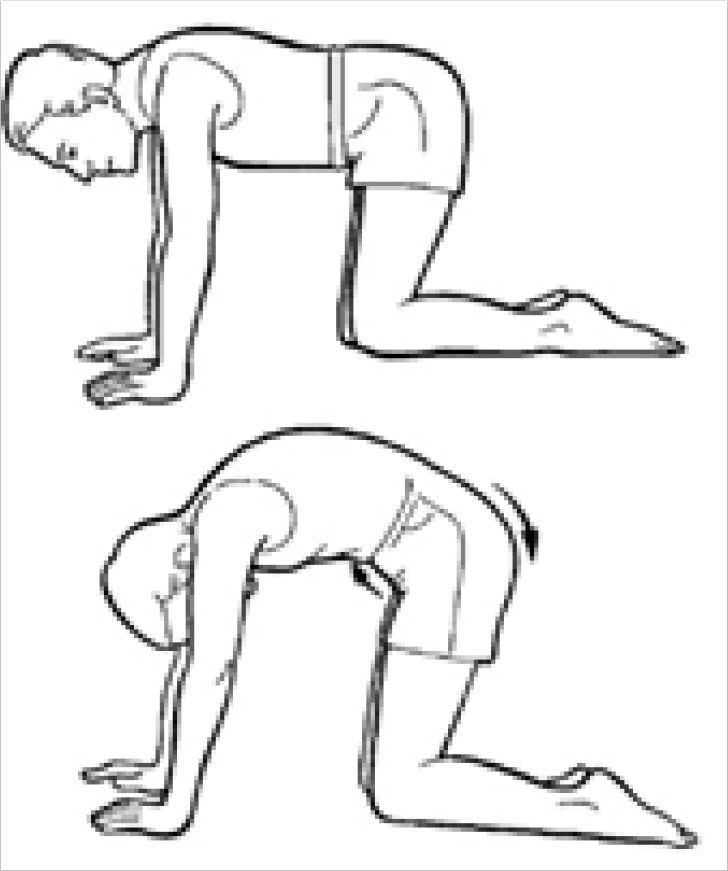
- Posterior Pelvic rotation (Pelvic Tilt)
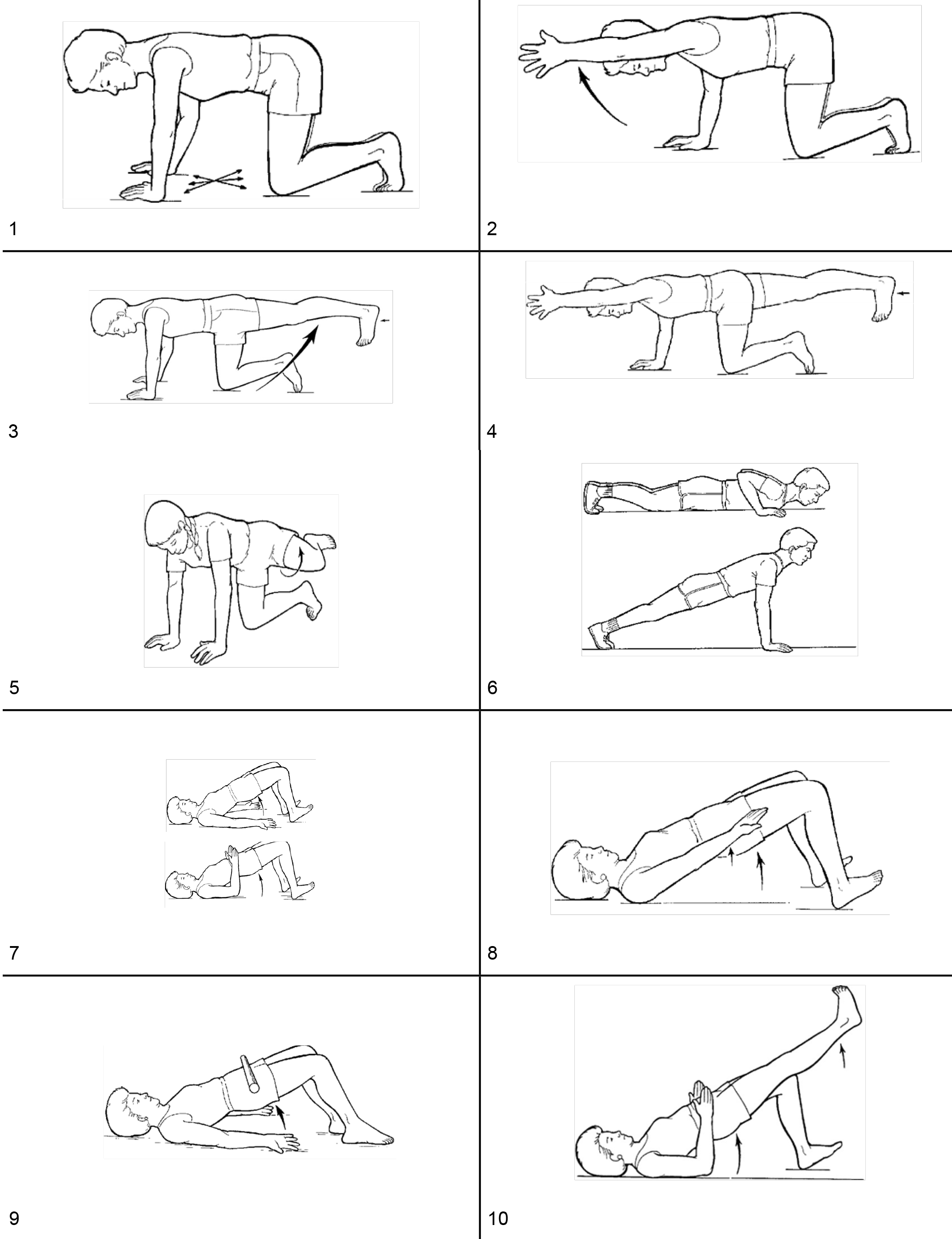
- Back Stabilisation Exercises (1-10)
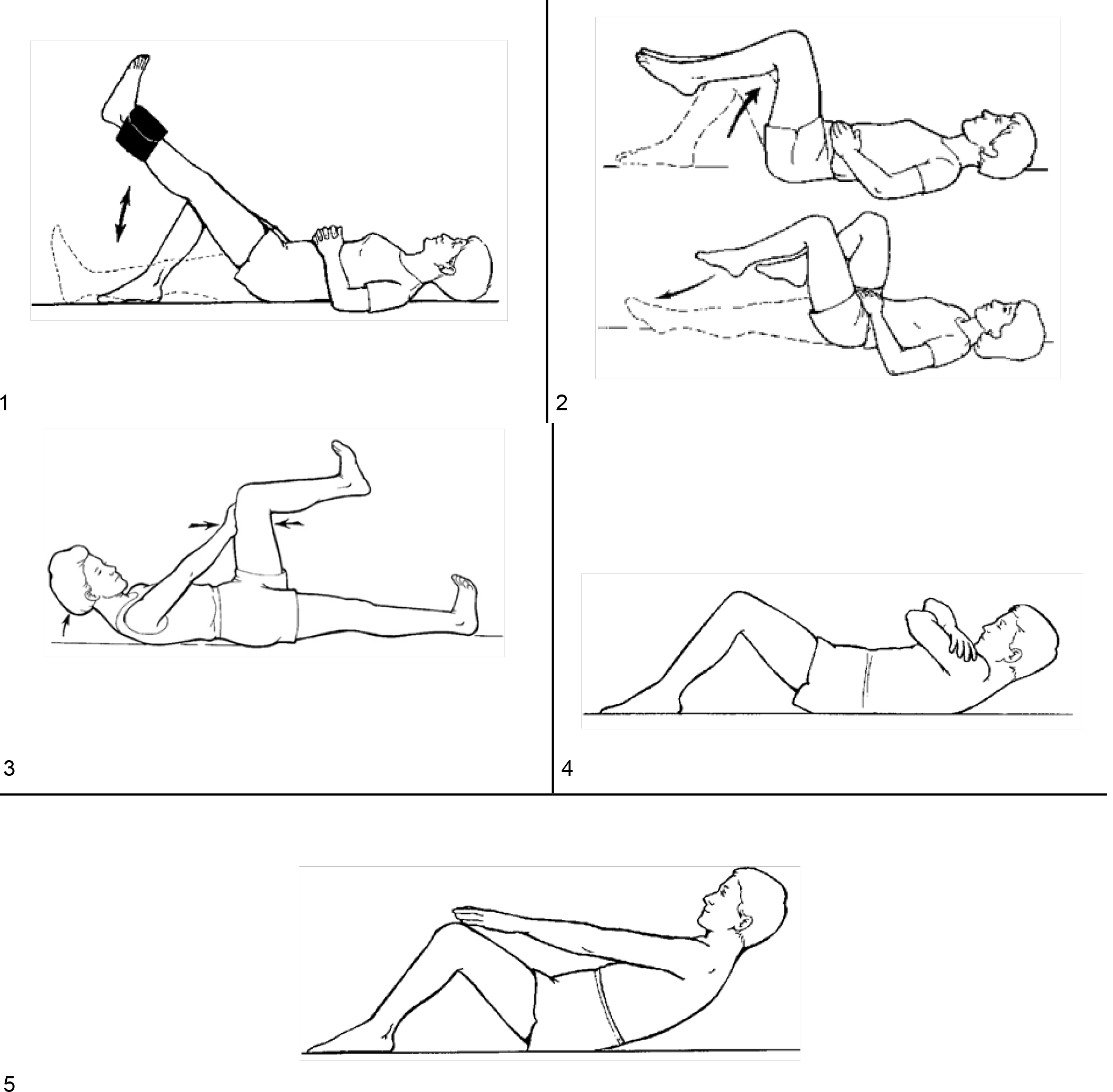
- Back & Abdominal Exercise (1-5)
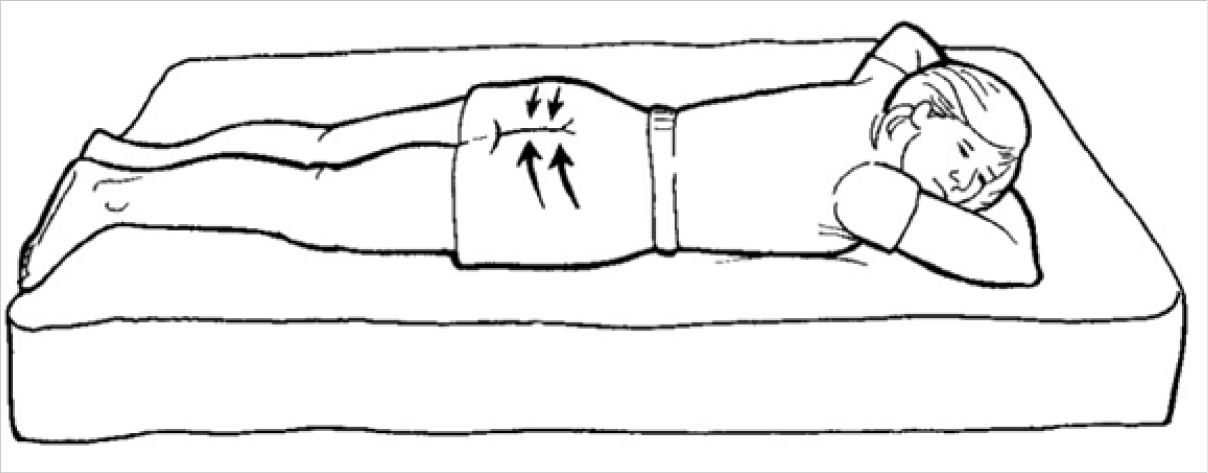
- Gluteal Sets
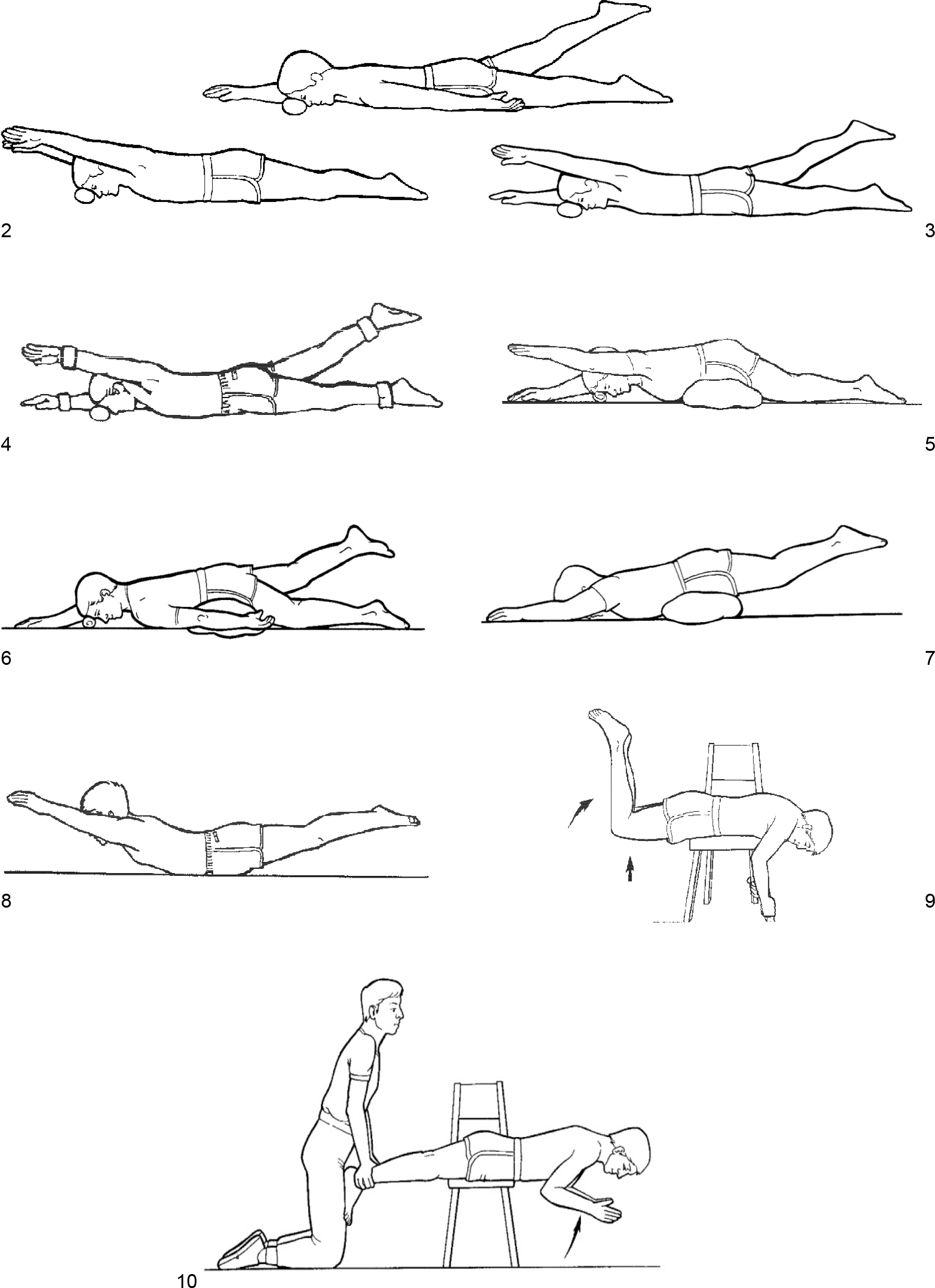
- Back Extension Exercise (1-10)
Post Course Assessment
The SF-36 questionnaire which assesses the quality of life was again administered to the subjects for assessing the present health condition (individual perception).
The Plank Test was chosen as an objective measure during pre and post testing to monitor the development and improvement in the core strength and endurance of the subjects over 12 weeks. The test was started with the subjects assuming the plank exercise position wherein they assumed prone position with the body parallel to ground, torso straight and rigid, resting the weight on toes and forearms. It was ensured that there was no bending or sagging and correct form was maintained during the test. A stop watch was used to time this exercise. The Plank test was repeated to check any improvement in performance thereby assessing the improvement in endurance of the lumbar trunk musculature.
| Group | Pre Trg (Sec±SD) | Post Trg (Sec±SD) | p value |
|---|---|---|---|
| Test | 104±0.06 | 140±0.20 | p<0.05 |
| Control | 98±0.03 | 114±0.02 | p>0.05 |
| P value | p >0.05 | p <0.05 |
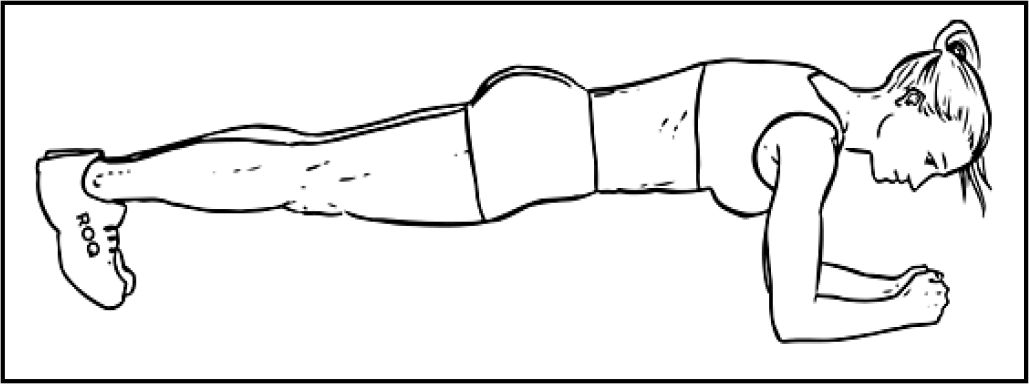
- Plank Test
RESULTS
20 out of 25 aircrew in the test group and complete 25 in the control group completed the entire schedule. The balance 5 in the test group managed an attendance ranging from 60 to 75 days. The latter was basically due to operational and other flying commitments. 23 completed SFquestionnaires were received from the test group giving a return rate of 92%. Amongst the control group 100% questionnaires were completed pre and post test.
The mean age of aircrew attending the course in the test group was 31 ± 5 yrs, they had an average service duration of 8.1 yr (range 1-16 yr). The average flying experience for the group was 1189 ± 826 hr. All the respondents agreed that backache is a problem with rotary wing aircrew. Of these 60% had experienced backache at sometime or the other during their flying career. For the afflicted, the frequency of such episodes was on an average twice per year. So far this had not resulted in any of the aircrew being permanently grounded for low back ache.
Paired t-test was applied for pre and post exercise analysis of data in each group. Independent sample t-Test was used to compare the data between the test and the control group. The plank test which was used as a measure of objective analysis showed a significant improvement in the test group from 104 ± 0.06 sec to 140 ± 0.20 sec (p<0.05) as compared to the control group. There was also a significant improvement in the quality of life domains (p<0.05) as tested by the SF 36 questionnaire vis a vis control group for subjective analysis. There was a significant difference observed between the test and control group post training in both objective and subjective tests (p<0.05) as compared to the Pre training value in both the groups.
| Domains | Trg Schedule | Test | Control | P Value |
|---|---|---|---|---|
| Functional capacity | Pre | 47.5±27 | 50.5±15.2 | >0.05 |
| Post | 87.5±31.4 | 58.5±27.5 | <0.05 | |
| p value | <0.05 | >0.05 | ||
| Physical Aspects | Pre | 20±38.7 | 24±2.9 | >0.05 |
| Post | 50±1.1 | 38±2.5 | <0.05 | |
| p value | <0.05 | >0.05 | ||
| Pain | Pre | 43.5±20.3 | 38±19.5 | >0.05 |
| Post | 91±9.9 | 29.7±8.8 | <0.05 | |
| p value | <0.05 | >0.05 | ||
| General Health | Pre | 62.2±17.9 | 57.9±23.5 | >0.05 |
| Post | 86.1±10 | 59±23.2 | <0.05 | |
| p value | <0.05 | >0.05 |
All the aircrew were comfortable with the present course schedule, the warm up jog and the freehand warm up. 80% of the aircrew felt that the back exercises worked up the spinal musculature, 70% felt that they had made gains in back muscle strength and 50% felt that there were improvements in spinal flexibility as compared to the control group which showed no significant difference. The aircrew were unanimous with respect to the feeling of relaxation induced by the cooling down techniques. 80% of the aircrew felt confident that after completion of the program they were fully capable of following the schedule of back and abdominal exercises on their own. Overall 70% of the participants considered the course beneficial whilst the balance rated the course as extremely useful.
DISCUSSION
This current exercise program was designed to reduce the incidence of low backache through back and core muscle strengthening. The program structure was deliberately kept flexible to allow for operational commitments of the helicopter units. The duration of the course was restricted to 12 weeks so that maximum number of participants can complete the program. The objective of the program was also to bring awareness among the participants on spinal hygiene and role of regular specific exercises to combat the problem of flight related backache. The program emphasised on imparting an effective Back Strengthening training to the participating aircrew so as to enable them to pursue the sameas a long term life style modification measure.
The plank test which is a valid, reliable and easy to perform method for assessment of global core muscle endurance was effectively employed in a number of studies [14, 15,16]. The results of this test among the test group had shown a statistically significant improvement in the holding time of the plank position. The study also brought out a complementary result regarding the employability of this test in the field condition.
All the participating aircrew had enthusiastically completed the course. The feedbacks indicate that the program did benefit to them in form of reducing the incidence and level of post flight backache. The program also helped to bring awareness amongthese aircrew about spinal health and hygiene.
Approximately 60% of the aircrew stated that backache interfered with the flying task. This finding can have serious flight safety ramifications because backache can be a major distraction in flight to the aircrew. There was a unanimous feeling that backache was caused due to poor seat design. The same has been reported in a number of studies [3, 6, 7, 8]. Further, 90% felt that the helicopter vibration also had some role to play in causation of this malady, especially in the frequency range of 12-15Hz [4, 5, 6]. This also has been well documented in literature.
The subjective analysis carried out by the SF 36 (Short form survey) questionnaire. This instrument has been used in several studies for assessing quality of life including in patients with chronic low back ache [17, 18, 19]. This is a reliable, validated questionnaire which measures two distinct concepts: A physical dimension and a Mental dimension which includes physical functioning (PF), role physical (RP), bodily pain (BP), general health (GH), vitality (VT), social functioning (SF), role emotional (RE), and mental health (MH). The physical dimension was scored and measured in this study. The significant improvement in the physical domain of the quality of life in the test group re-emphasises the role of a structured exercise program for the aviators especially helicopter pilots.
CONCLUSION
Based on the results of the study, It can be concluded that a the specific exercise program which was employed for improving back and core strength of the aircrew can have subjective as well as objective benefits. This study also brought out the effectiveness of assessing the strength and endurance of back muscle by employing Plank test in field condition. It also substantiates the findings of previous studies on evaluating the exercise program for increasing the endurance of back muscles [11, 20]. The results though appear to be encouraging, further studies need to be undertaken to substantiate the results. However, the true incidence of post flight back ache among the beneficiaries was not studied and this could be a limitation of this study. But from the limited information generated from this study it can be concluded that a back strengthening program may be a viable way to prevent backache in helicopter aircrew and should be considered as a primary preventive strategy for helicopter crew.
References
- Task and postural factors are related to back pain in helicopter pilots. Aviat Space Environ Med. 2002;73(8):805-11.
- [Google Scholar]
- Low back pain in Norwegian helicopter pilots. Aviat Space Environ Med. 2001;72(3):161-64.
- [Google Scholar]
- Vibration. In: Gradwell DP, Rainford DJ, eds. Ernsting’s Aviation and Space Medicine (5th ed). Florida (USA): CRC Press; 2016. p. :213-28.
- [Google Scholar]
- Vibration and Acoustics In: Jeffrey RD, Johnson R, Stepanek J, Fogarty JA, eds. Fundamentals of Aerospace Medicine (4th ed). Philadelphia (USA): Lippincott Williams & Wilkins; 2008. p. :110-41.
- [Google Scholar]
- Backache in Chetak crew and suggested ergonomic improvements in aircraft seat design. Ind J Aviation Medicine. 1983;27:123-25.
- [Google Scholar]
- Orthopaedics. In: Rayman RB, Devenport ED, Rampon DM, Giltow S, Hastings JD, Ivan DJ, Kruyer WB, Pickard J, eds. Rayman’sClincal Aviation Medicine (5th ed). New York (USA): Castle Connolly Graduate Medical Publishing Ltd; 2013. p. :293-6.
- [Google Scholar]
- Low backache among Chetak helicopter pilots: Trial of lower lumbar cushion at a flying unit. Paper presented at the XLI Annual Conference of Indian Society of Aerospace Med.
- Helicopter crew conditioning program: Our experience. Ind J Aerospace Med. 2005;49(1):11-14.
- [Google Scholar]
- Is backache a serious malady among Indian helicopter pilots: A survey report. Ind J Aerospace Med. 2006;50(2):13-19.
- [Google Scholar]
- Sport specificendurance plank test for evaluation of global core muscle function. Physical therapy in sport. 2014;15:58-63.
- [Google Scholar]
- A clinical tool for office assessment of lumbar spine stabilization endurance: prone and supine bridge maneuvers. Am J Phys Med Rehabil. 2007;86(5):380-6.
- [Google Scholar]
- SF 36 total score as a single measure of health related quality of life: scoping review. SAGE Open Med. 2016;4:2050312116671725.
- [Google Scholar]
- Health related quality of life assessment in patients with low back pain using SF 36 questionnaire. Medicina(Kaunas). 2007;43(8):607-13.
- [Google Scholar]
- A low back specific version of the SF 36 physical functioning scale. Spine (Phila Pa 1976). 2004;29(5):586-94.
- [Google Scholar]
- Low back pain in the AH-1 Cobra helicopter In: Aviation Space & Environmental Medicine. Vol 58. 1987. p. :315-18.
- [Google Scholar]






